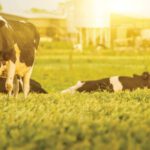According to the USDA, roughly 37% of the U.S. states are classified as experiencing extreme or exceptional drought as of September 2022. As water and feed sources are drying, many farmers are making the difficult decision to reduce their herds. For people facing that decision, there are two tax treatments to understand and discuss with a tax advisor.
“Each case is unique from a tax application, and the circumstances surrounding the drought will also vary. The important thing to remember is that options exist for many situations and specialized tax advisors can help ranchers sort through the tax treatments to protect their livestock and livelihood,” says Paul Smith, Pinion animal ag advisor.
Treatment One: Election to postpone gain by purchasing replacement livestock
Treatment one is specifically for situations where draft, breeding, or dairy animals (excluding poultry and sporting animals) are sold in ‘excess of normal’ due to weather-related challenges. Ranchers can postpone reporting the gain on the sale of that livestock by purchasing replacement animals within two years.
To qualify:
- The rancher must use the proceeds of the sale to purchase replacement livestock within two years of the end of the tax year of the sale.
- Replacement livestock must be like-kind and like-use. The new livestock must be used for the same purpose as the livestock sold. Beef cows must be replaced with beef cows, not stocker cattle, feeder cattle, or dairy cows.
- The same amount deferred must be spent. If $120,000 is deferred, then $120,000 will need to be spent on the replacement animals.
Deadline: Farmers have two years from the point of sale to replace the livestock. However, this can be extended to four years if their area is eligible for government assistance.
Treatment Two: Election to defer income to subsequent tax year
This rule is applicable to all livestock. It allows ranchers who sold livestock in ‘excess of normal’ due to drought to report the income of the excess sales in the next year.
To qualify:
- The farmer must show that the animals were sold in excess of normal due to weather challenges. To do this, compare the drought years’ livestock sales to the average sales of the past few years. The number of livestock sold in excess of the average is the amount that can be deferred. A common example is a producer that retains its calf crop and runs them on wheat pasture in the fall, selling them in the spring. But, due to drought, they are forced to sell the calves in the fall. This rule prevents the producer from having to report the income of two calf crops in one year.
- The primary income must come from farming.
- The area must be declared a drought area.








